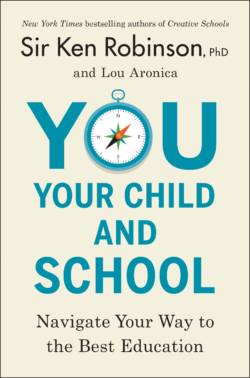Excerpt from You, Your Child, and School: Navigate Your Way to the Best Education by Sir Ken Robinson, Ph. D and Lou Aronica, published on March 13, 2018 by Viking, an imprint of Penguin Publishing Group, a division of Penguin Random House LLC. Copyright by Ken Robinson, 2018.
Room to Maneuver
There’s more room to make changes within the current education system than many people think. Schools operate as they do not because they have to but because they choose to. They don’t need to be that way; they can change and many do. Innovative schools everywhere are breaking the mold of convention to meet the best interests of their students, families, and communities. As well as great teachers, what they have in common is visionary leadership. They have principals who are willing to make the changes that are needed to promote the success of all their students, whatever their circumstances and talents. A creative principal with the right powers of leadership can take a failing school and turn it into a hot spot of innovation and inclusion that benefits everyone it touches.
Take Orchard Gardens elementary school in Roxbury, Massachusetts. Ten years ago Orchard Gardens was in the doldrums. By most measures, it was one of the most troubled schools in the state. The school had five principals in its first seven years. Each fall, half the teachers did not return. Test scores were in the bottom 5 percent of all Massachusetts schools. The students were disaffected and unruly and there was a constant threat of violence. Students weren’t allowed to carry backpacks to school for fear that they might use them to conceal weapons, and there was an expensive staff of security guards, costing more than $250,000 a year, to make sure they didn’t. Remember, this was an elementary school.
Principal number six, Andrew Bott, arrived in 2010. People had told him that becoming principal at Orchard Gardens would be a career killer. He knew its reputation as one of the worst-performing schools in Massachusetts and admits that when he arrived it did feel like a prison. He had a radically different solution to its problems, which shocked many observers. He decided to eliminate the security staff altogether and invest the money in arts programs instead.
 The school was enlisted as one of eight pilot schools for a new plan created by President Obama’s Committee on the Arts and Humanities (PCAH). In the next two years, Bott replaced 80 percent of the teachers and recruited others with special expertise in the arts: teachers who believed in his new vision for the school. “This was a far better investment,” said Bott, than “spending a quarter of a million dollars on six people to chase a few kids around who are misbehaving.” Together they introduced strong systems to support students as individuals. They lengthened the school day and started a data-driven approach to school improvement from monitoring attendance to test scores. And they focused on reinvigorating the school culture as a whole. They bought instruments, invited artists to come into school to work with the children, and ran creative workshops for the teachers and parents. The arts classes gave the students fresh enthusiasm for learning, and the walls and corridors were soon covered with displays of their work, which itself created a more stimulating environment and sense of ownership by the children. “Kids do well,” Bott said, “when you design and build a school that they want to be in. Having great arts programs and athletics programs makes school an enjoyable place to be and that’s when you see success.”
The school was enlisted as one of eight pilot schools for a new plan created by President Obama’s Committee on the Arts and Humanities (PCAH). In the next two years, Bott replaced 80 percent of the teachers and recruited others with special expertise in the arts: teachers who believed in his new vision for the school. “This was a far better investment,” said Bott, than “spending a quarter of a million dollars on six people to chase a few kids around who are misbehaving.” Together they introduced strong systems to support students as individuals. They lengthened the school day and started a data-driven approach to school improvement from monitoring attendance to test scores. And they focused on reinvigorating the school culture as a whole. They bought instruments, invited artists to come into school to work with the children, and ran creative workshops for the teachers and parents. The arts classes gave the students fresh enthusiasm for learning, and the walls and corridors were soon covered with displays of their work, which itself created a more stimulating environment and sense of ownership by the children. “Kids do well,” Bott said, “when you design and build a school that they want to be in. Having great arts programs and athletics programs makes school an enjoyable place to be and that’s when you see success.”



